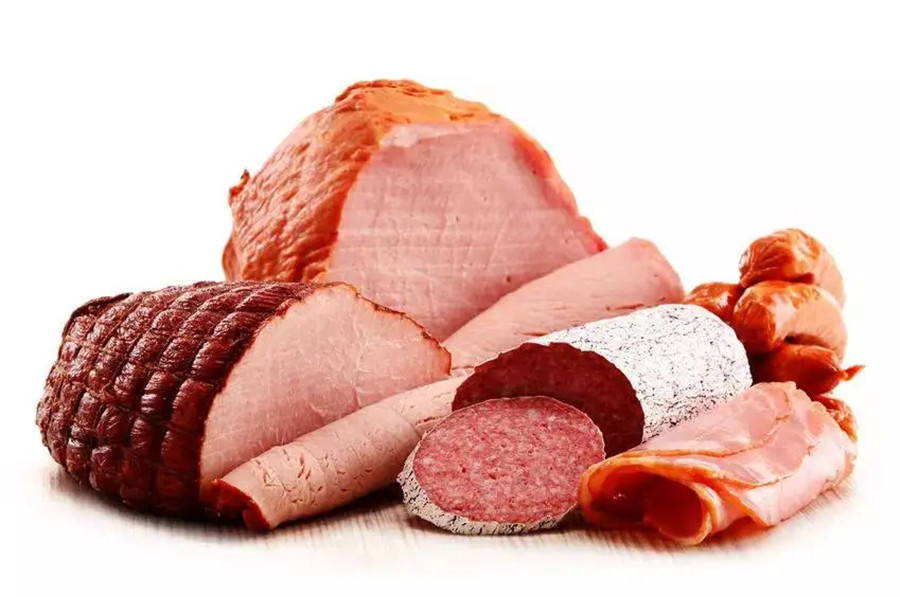Most meat products have to go through the process of marinating in the process of processing, which promotes the maturity of meat products, increases the flavor of meat products, and stabilizes the sensory state of the products. During the processing of meat products, due to the different marinating methods and time, as well as the influence of production technology, packaging, and other factors, a variety of products with unique flavors are formed. From the technical point of view, the quality of pickling will affect the next process, and can also determine a series of results such as the structure, flavor, and color of the final product. Now with the development of food processing science and technology, people have a new understanding of the marinating of meat and have carried out in-depth research. The marinating of meat has been widely used in production as an important processing method, and preservation is only one of the purposes of marinating. This article provides an overview of some basic issues with pickling as follows.
Composition and Properties of Meat
The main components of meat include protein, fat, moisture, ash content, and other substances. The content of these components may vary due to factors such as animal species, age, nutrition, and location. In meat processing, not only the physical properties and chemical composition of different raw meats, but also the difference in water retention capacity and meat color of PSE and DFD, and the pH value should also be considered. The moisture content of raw meat is generally between 70 and 80, and the crude protein is between 17 and 22. The crude fat is generally different according to different varieties and parts, and the ash content is about 1.

Meat temperature is a very important link in the processing process, and it is inevitable that the meat will be contaminated by bacteria from the time of slaughtering. For this reason, the temperature control of meat is a necessary condition for each link, so factors such as room temperature, processing machine, and water temperature are all critical to the meat. The amount of time is also a necessary condition that affects the process. The marinating temperature is limited to between 3 and 5°C, and the marinating time depends on the size and method of the meat. The termination temperature of chopping and mixing should be below 12°C, and the temperature suitable for microbial growth should be avoided at 20-40°C for smoking and drying.
Pickling Purposes and Materials
1. Purpose of Pickling
1.1. The purpose of marinating has the following aspects: preventing the corruption of the meat and prolonging the preservation time. The meat has a good color due to the action of nitrile. Improve the water retention and binding force of meat. Enhanced meat flavor by improving product flavor structure through marinating.
2. Pickling Materials and Functions
2.1. Salt
The main component of table salt has a NaCl content of more than 85%. In addition to this, there are impurities such as Ma, Ca, and so on. After the salt hydrolysis, H2O gathers around Na+ and Cl- to form hydrated ions, and the increase of hydrated ions will lead to the decrease of free water and the decrease of water activity to a certain extent. When the water activity is less than 0.75, most bacteria and yeast cannot grow. When the salt concentration is 1%, its osmotic pressure will destroy the microbial cytoplasmic membrane, causing it to lose water, thereby inhibiting the growth of microorganisms. In addition, when the enzymes secreted by microorganisms are in a lower concentration salt solution, the salt will combine with the peptides in the enzyme protein, and its original shape and structure will be denatured, destroying the ability of the enzyme to decompose meat protein. These environments are not conducive to the growth of microorganisms.

2.2. Water Holding Capacity of Meat Products
It refers to the moisture content of the meat and the retention capacity of the moisture added to the meat. The water content of most animal muscles is about 75%. After heating, whether the water can be retained in the original state to the greatest extent, or the water added from the outside can be better maintained under the action of external conditions. These are the factors that determine the product. A big reason for the good and the bad. Through experiments, it was found that the ionic strength of NaCl is the highest when the ionic strength is 0.8 to 1.0, and the water holding capacity decreases beyond this standard. Most of the pickling preparations are salt, and the water holding capacity is mainly affected by the salt during the pickling process. The main material for the water-holding and binding properties of meat is the protein in the muscle. Usually, under pickling conditions, the ionic strength of NaCl is about 0.6, and the processing time is 24-48h. Due to the effect of ionic strength, a large amount of myosin is extracted from the muscle. The protein in a non-dissolved state is transformed into a dissolved state, or from a gel state into a dissolved state. This transition is the root cause of the increase in meat water holding capacity.
Myosin in the gel state can also absorb a certain amount of water and swell due to solvation. But this water holding capacity without sufficient ionic strength is very limited. During the heating process, due to the denaturation of the protein, the non-polar groups originally contained in the secondary structure of the protein are exposed, and its hydrophobicity greatly reduces the water-holding capacity of the meat. Uncured meat loses water when heated, which is why.
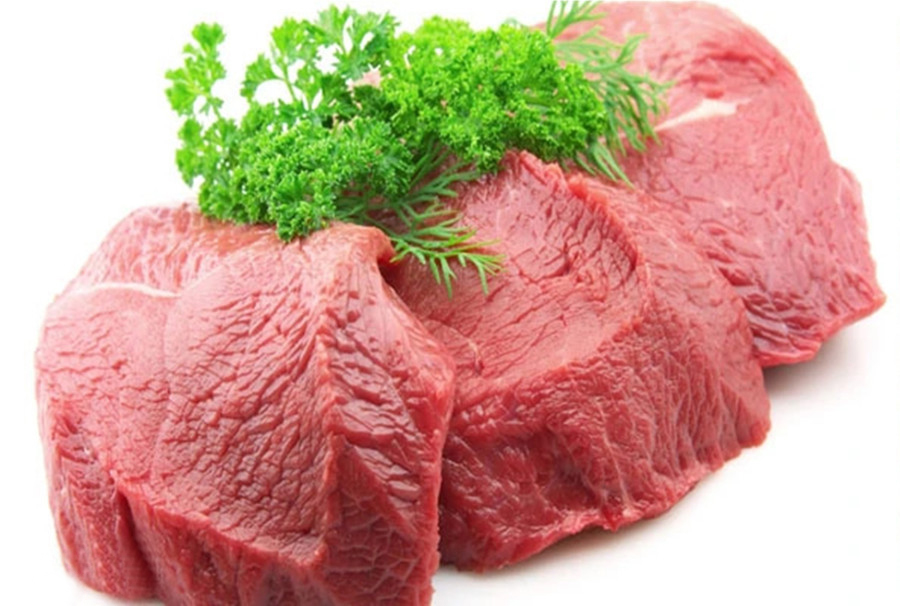
After pickling, the myosin in the gel state in the meat is transformed into a sol state with a considerable concentration, the swelling ability is greatly enhanced, and the process of high solvation is realized. Under a certain ionic strength, the solvation is most fully carried out, and the water-holding capacity is the highest. In the process of processing, the myosin in the form of sol is released from the cells by mincing and stirring, and it acts as an adhesive. When heated, the sol-like protein forms huge aggregates that trap water and fat in the aggregate network. Of course, in the actual processing process, a certain amount of pyrophosphate or polyphosphate is often added to increase the extraction of protein, strengthen the binding force between tissues, and improve the water-holding capacity of the product.
3. The Mechanism of Color Development in Pickling
In order to make the cured meat produce bright red color, inhibit the growth of microorganisms and generate a special flavor, nitrate or nitrite are often added to the cured meat preparations. Nitrate is reduced to nitrite in meat by reducing bacteria, generally a product that has been cured for a long time. We all know that the red substances in meat are mainly myoglobin and hemoglobin in meat, and hemoglobin is lost due to animal slaughter. In the presence of NO2-, myoglobin reacts with oxygen to produce reddish-brown methemoglobin. Nitrous oxide generates nitric oxide through the action of reducing bacteria in meat, and nitric oxide reacts with ferromyoglobin to generate nitric oxide myoglobin, which generates bright red NO hemoglobin after heating. In the actual pickling process, the color development aid L-ascorbate is often added to accelerate the reduction of methemoglobin. It can also prevent the oxidation of myoglobin and stabilize the color of meat products.
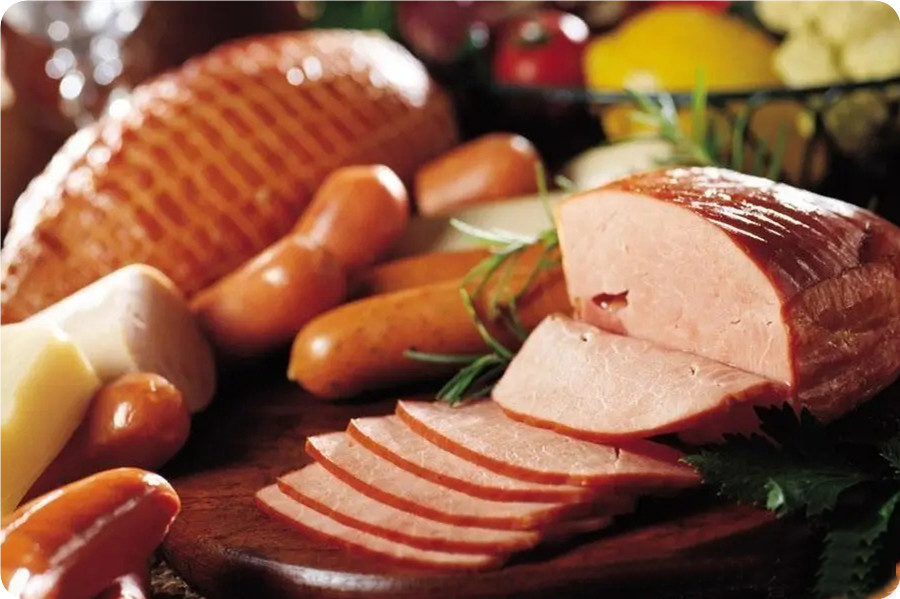
3.1. Residual Amount of Nitrite
Nitrous acid is a chemically active substance, which itself acts as an oxidant, releasing O2 to become NO. On the contrary, nitrous acid can also be oxidized into nitric acid. In the reaction, nitrous acid is consumed in the meat at the same time, but its consumption is not simple, so the residual amount of nitrite and nitrate has no fixed relationship with the curing time. In order to ensure the health of consumers, different countries have regulations on nitrite residues. Chinese ham, smoked boiled sausage, ham sausage, Chinese sausage≤30×10-6. The residual amount of nitrite is basically 25% of the added amount.
3.2. Other Pickles
In the curing process of meat products, the main curing agents such as salt and nitrite are used. In addition, according to different products, polyphosphate, glucose, Vc, spices, etc. are also added in the marinating process to form different flavors. Moisture retention agent phosphate, mainly sodium tripolyphosphate, sodium hexametaphosphate, sodium pyrophosphate. Due to the addition of phosphate during pickling, the pH value increases, which can increase the water-holding capacity of the meat, improve the tenderness of the meat, and enhance its adhesion. The effect of combined use is better than that of single-use. 20% sodium hexametaphosphate, 40% sodium tripolyphosphate, and 40% sodium pyrophosphate are commonly used together and are generally added according to 0.2% to 0.5% of the meat. The addition of spices can increase the special flavor of the product and remove the peculiar smell of the product. Sometimes preservatives and antioxidants are added in pickling, which is selected according to the needs of product design, but it has a certain distance from the real purpose of pickling.
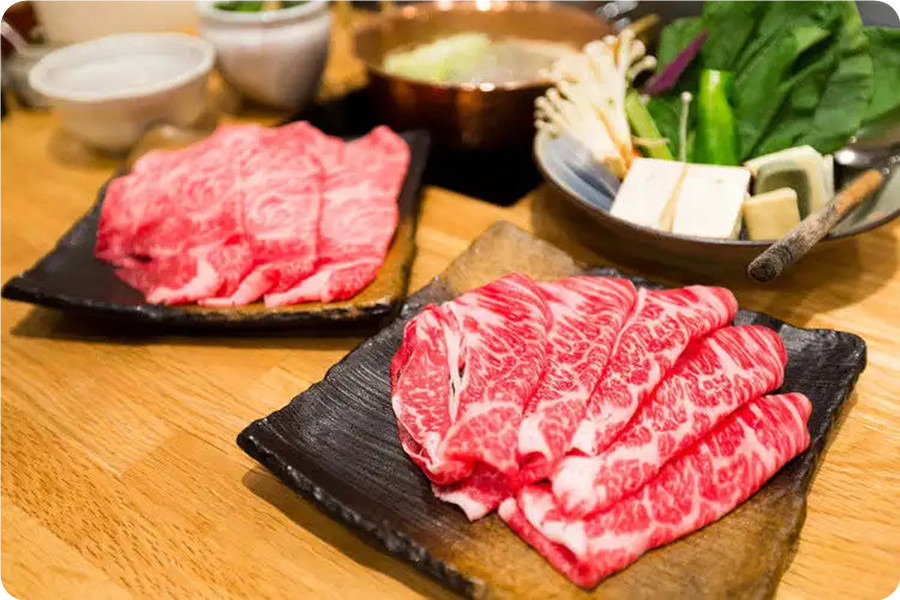
3.3. Maltol
There are also cases in which nitrite is not used in the processing of meat products, but iron salt is used in combination with maltol in the processing process, which will show the same color as nitrite. An important chemical property of maltol is that it turns purple in the presence of iron ions. The recommended iron salts can be ferric gluconate, ferric citrate, etc., which not only achieves hair color but also increases the content of trace elements. Maltol accounts for 0.7% of the meat, but to control the formation of microorganisms during the curing process. Monascus red is a natural pigment extracted from red rice. It is very stable in nature and has good dyeing properties for proteins. The formation of microorganisms should also be considered.
Pickling Method
The correct selection of the pickling method plays an important role in the post-processing process of the product and the quality and formability of the final product.
1. Dry Curing
The so-called dry marinating method is a marinating method in which the marinating agent is directly mixed with the meat or smeared on the surface of the meat or a method in which large pieces of meat and meat particles are stirred evenly to absorb the marinating agent. The advantages of this method are simple operation, less nutrient loss, and high salt concentration and color-forming agent concentration around the meat, which inhibits the reproduction of bacteria and is easy to store for a long time. The disadvantage is that fat is easily oxidized. Dry curing is suitable for Chinese ham, Chinese bacon, dry sausage, air-dried poultry, etc. The dry salting method has a longer cycle, so the product has a greater impact on the batch and scale.
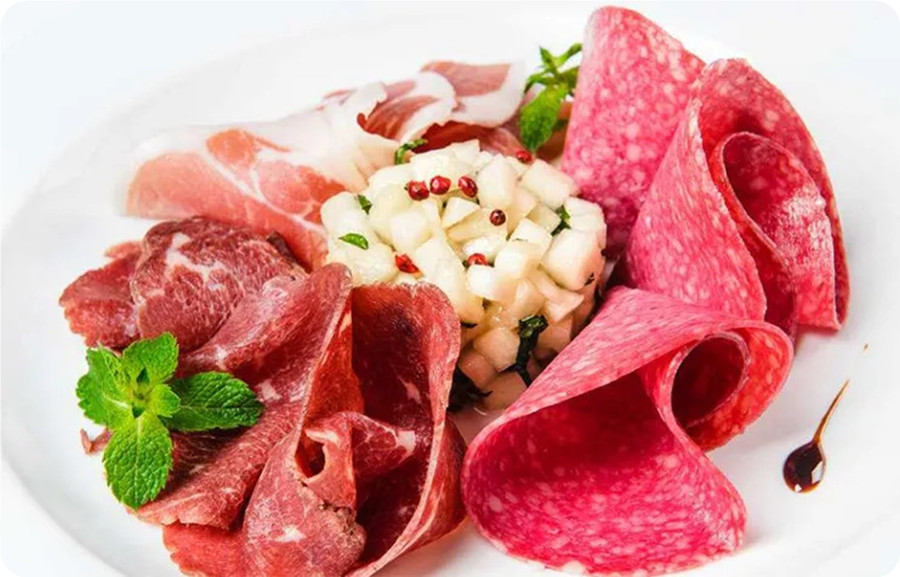
2. Wet Pickling
The wet pickling method is to prepare a certain concentration of pickling agent solution in the container in advance, and through diffusion and water transfer, the pickling agent penetrates into the interior of the meat to obtain a relatively uniform distribution. The method of curing until its concentration is finally the same as the concentration of the salt solution. Wet curing can better promote the maturity of meat, especially ground meat. When marinated at 0-4°C for 24-48h, the water holding capacity and binding property are greatly increased. So it has good color, flavor, and structure. The disadvantage is that the reproduction of microorganisms for a long time of pickling will lead to product rancidity, fermentation, and other phenomena. Wet pickling is no longer commonly used, mainly due to the introduction of injection and tumbling processes. However, some Chinese-style braised pork products and Western-style ham products without injection also use this kind of process, and the products made have unique flavor characteristics.
3. Semi-dry and Semi-wet Pickling
The marinating method in which the marinade is dissolved in a small amount of water and then mixed with the meat and stirred evenly is called the semi-dry and semi-wet marinating method. This method combines the advantages of dry curing and wet curing and is mostly used in fresh sausage minced ham.
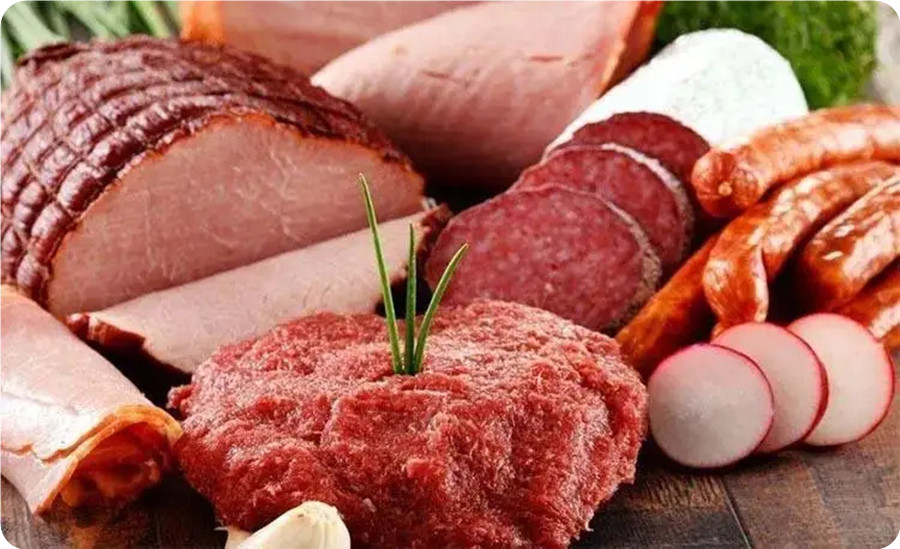
4. Injection Pickling
The injection pickling method is a more advanced pickling method than the previous two methods, and it is a new pickling method with the development of food machinery. It is a marinating method of pre-preparing salted brine, injecting the meat with an injection machine, and then letting it stand or tumbling. The injection pickling method combines the advantages of wet pickling and dry pickling. It has the advantages of fast dispersion of pickling liquid, short pickling cycle, good effect, and high efficiency, and is widely used in meat processing. This method is generally carried out in combination with the rolling and kneading process and is an important means of modern meat processing. The injection curing method is suitable for Western-style ham, bone-in poultry, Chinese-style flexible packaged meat products, sausage products with exposed meat pieces, some Western-style roasted meats, etc.
Factors that Affect the Effect of Pickling
1. Temperature and Time
High temperature can promote the marinating of meat, shorten the marinating time of meat and prolong the marinating time. However, if the temperature is too high, the growth of microorganisms will increase and the meat will easily rot. Measures: Choose the appropriate temperature and time. Generally, when the meat is marinated, the ambient temperature should be between 0 and 4°C, and the meat temperature should not exceed 7°C. Pickling at this temperature for 18 to 24 hours can basically achieve better pickling quality.
2. Air (Oxidation)
When the meat is marinated in the air, the surface of the meat turns brown due to the action of oxygen. Measures: The upper layer of the cured meat should be covered with a clean cloth (plastic paper).
3. Complex Phosphate
Excessive use of phosphate will affect the color of meat. This is because the pH value rises too high, so the pH value is best at 6.0. Measures: Add according to the standard of food additives. General compound phosphate added ≤ 0.5%.
4. Nitrate or Nitrite
It is because of the addition of nitrate or nitrous that the meat develops well. But excessive use, on the one hand, the residue of nitrous is too high, which affects human health, and on the other hand, it is easy to make the HNO2 in the meat excess, so that the meat produces green substances. If it is used too little, the color effect will be affected due to the insufficient amount of nitrous. Measures: Add according to the standard of additive use, that is, 0.15g/kg meat. Use auxiliaries such as sodium ascorbate with nitrous, but should be added after nitrous.
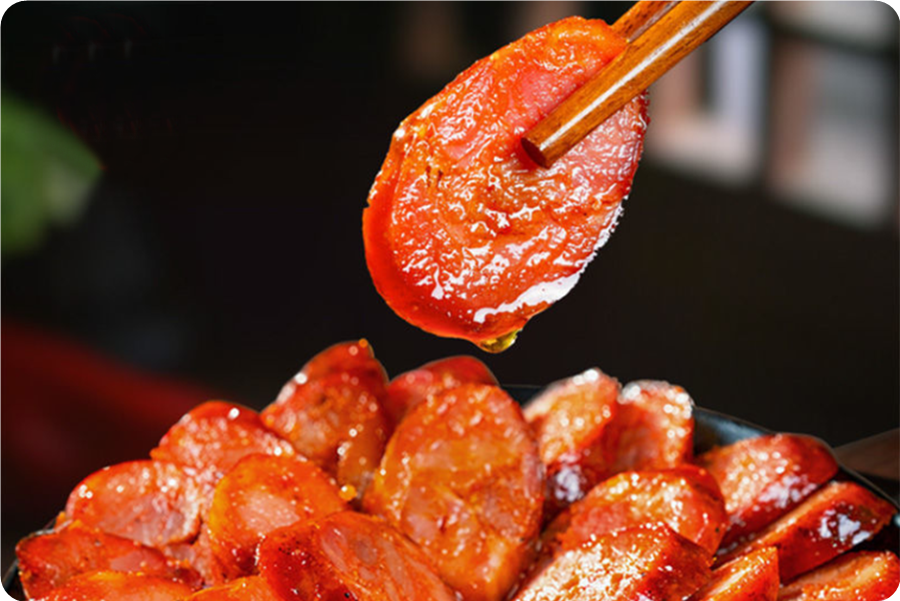
5. Small Amount of Nitrite Substitute Pickling System
There are currently no substitutes that completely replace the role of nitrite in cured meat products, so a small amount of nitrite needs to be added to the curing system, but other substitutes need to be added. Such substitutes mainly play a role in promoting color, bacteriostasis, antitoxin, and blocking the formation of nitrosamines. The study found that a mixture of 550mg/kg ascorbate and 550mg/kg tocopherol was very effective in inhibiting the formation of nitrosamines. The amount of nitrite added can be reduced to 120mg/kg, but further toxicity tests and mutation tests are needed.
Adding lactobacillus-producing bacteria in meat processing will increase the amount of sucrose and reduce the amount of nitrite to 40mg/kg. The sensory and taste are the same as when nitrite is used alone. Lactobacillus-producing bacteria can be selected from Streptococcus nisica, Bulgaricus, Lactobacillus acidophilus, and the like. The concentration of lactic acid bacteria added is 0.2% to 1%, and the addition amount is 10mL/kg. Inhibit the reproduction of other bacteria, thereby reducing the nitrate content. After the test, the amount of nitrate added is only 0.01% to 0.06% of the original. At present, there are potassium sorbate, lactic acid, salt tannic acid, gallic acid, fumaric acid, ethylenediaminetetraacetic acid, hypophosphite, and so on.
Preserving meat products is an important means of meat product processing, which improves the flavor and quality of meat products and enhances the antiseptic and bacteriostatic effect. However, when marinating meat, we must pay attention: according to the nature of the product, choose the correct marinating method, rationally use the marinating agent, and pay attention to and strengthen the prevention of influencing factors. Only in this way can a good marinating quality be guaranteed and a high-quality meat product can be produced.

